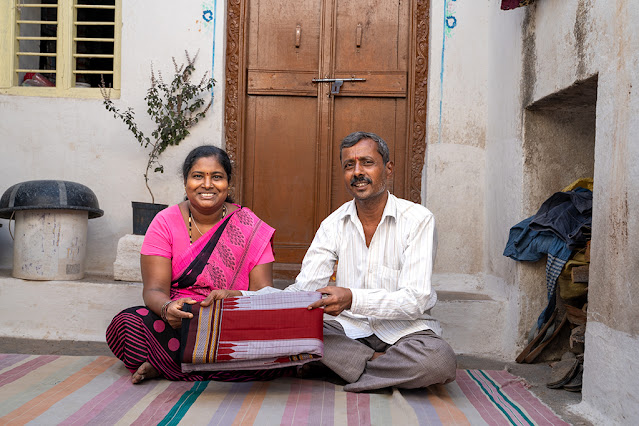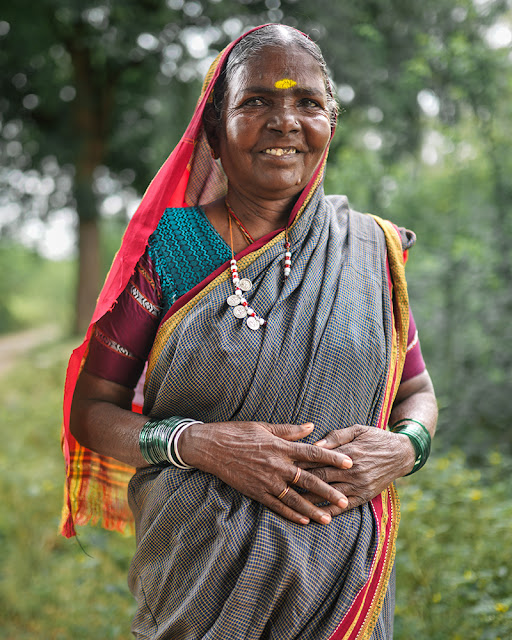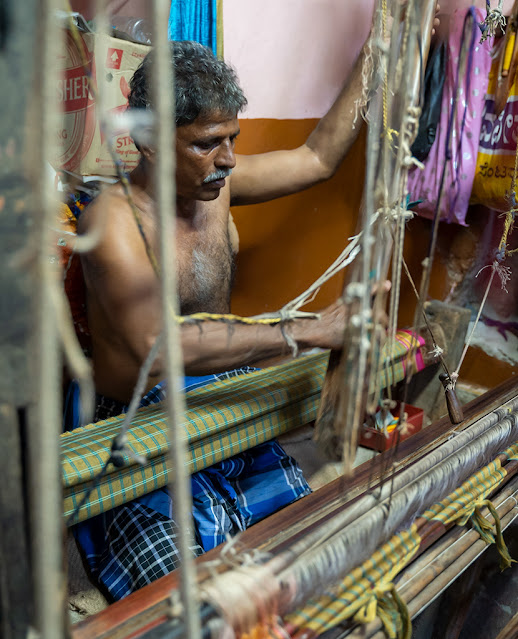Celebrating South Indian sarees and Karnataka’s Ilkal saree weavers - a journey with tvami
My journey started in Pune and ended several hours later in a small town I had never even heard of before - Ilkal. Ilkal is located about 100km from Hospet in North Karnataka. The town isn’t on anyone’s travel maps, and I was also not here to travel. Then why did I spend five days in Ilkal?
I was in Ilkal for a very special project - to make a film about a centuries-old craft that originated from the town. I am, of course, referring to the iconic Ilkal saree which is woven in Ilkal and other small towns around, and also gets its name from the town. These are handloom sarees which have historically been extremely popular across North Karnataka and Maharashtra. These sarees are woven using cotton yarns, which make them perfect for the hot weather in this region, and the bright silk pallav gives them a unique look. More on the sarees and their speciality later in the article.
 |
| A detailed view of Ilkal saree |
Let’s talk about the film I made, and even before that let’s talk about the organisation that I made this film for - tvami.
What is tvami?
tvami was founded by Minakshi Prabhu during the tough lockdown days when she learnt how the handicrafts sector - which is the second largest employer in India - was reeling under a multitude of threats, posing an existential crisis for many. tvami was born to support the artisans and their crafts. Currently they are based out of Bangalore and work with artisans across India.
 |
| Minakshi with the weaver's family near Ilkal |
In Sanskrit, the word tvam means you, your roots, your true nature. Drawing inspiration from it, the name tvami was coined, where the 'i' represents the many artisans and artisan groups across India that handcraft, paint or weave objects of art. tvami endeavours to connect consumers to practitioners of traditional arts and crafts, and spread awareness about their intrinsic beauty and value, thereby making a positive impact on the artisans’ livelihoods.
 |
| Weavers at Ilkal |
 |
| Ashok Sakri and his wife Jayashree at Dotihal |
The genesis of tvami is influenced by a series of personal experiences in Minakshi’s life - alternate education, segregation, composting and more importantly meeting with numerous individuals across the country. In her interactions, she observed the rising discontent among the urban population over the unsustainable never-ending hustle lifestyle. Yet, she could also see an expanding percentage of the rural population seeking to move to the cities in search of the same lifestyle. These contradicting trends made her conclude that it was time to draw inspiration from the villages and find solutions at the grassroots.
Having spent considerable time in urban and rural settings, Minakshi has always been cognisant of the talent pool available in the villages and the immense potential the local artisans’ skills and crafts hold. In her opinion, it is only a matter of providing enough opportunities in their native place, which shall help fulfil their aspirations and contribute towards their social upliftment. Staying closer to family with sustainable means of livelihoods and inculcating deep societal bonds is the way forward. Thus, tvami’s core modus operandi includes working with small and marginalised artisans in the clusters to help them reach markets which were earlier inaccessible to them and further help them earn a justified premium for their hard work.
 |
| Govindappa Kambad - One of tvami's weavers at his home |
Even in Ilkal, tvami is working with small weavers like Govindappa Kambad. The veteran weaver has endless tales to share about the prestige associated with handloom weaving in his heydays. However, strenuous challenges faced by the weavers over several decades as well as hardship brought due to a series of personal tragedies, forced Govindappa to take up work in a granite quarry instead. With age not on his side and his undying passion towards the craft, he returned to weaving. He is hopeful that with the support and efforts from organisations such as tvami, the profession will become rewarding once again, and help weavers like him earn a sustainable livelihood.
You can also join in the tvami movement by supporting the artisans by purchasing products from them. Check out the website for more details. Their products are great for gifts, for decorating your own house as well as to buy garments made by artisans, such as the Ilkal sarees.
The Story of Ilkal
As I mentioned earlier, the protagonists of this story are the Ilkal sarees, and the weavers who make these. For most weavers in the cluster, weaving Ilkal sarees is a generational craft with the required fine skills passed on to them from their elders. They typically work as individual weavers, as part of a cooperative, or as a group under a master weaver.
 |
| A local woman in an Ilkal saree |
 |
| Making of the Ilkal saree |
 |
| A weaver busy making a saree |
 |
| Ilkal weaver Shamanna Muggani |
The sarees are not just a piece of fabric, intricately woven. Their beauty lies in how they bind a family and a community together. The journey of the saree starts from the raw material. The yarn is often procured from the wholesale markets in bulk and then dyed in local dyeing units. The next step is weaving. The looms are often at the homes of the weavers and are pit looms. Family members contribute at each stage of the weaving process - such as reeling, tana, etc.
he distinctive features of the Ilkal saree are the checks across the body of the saree, the motifs on the pallav, such as topteni, and kyadegi, and the border patterns, such as gomiteni, chikiparas and gayatri. The standout feature is how the pallav is interlocked with the rest of the saree using a special technique called the kondi. Typically the father and daughter or the husband and wife, weave the pallav together. The entire cycle reflects a cooperative movement that starts right from the home.
 |
| Details of a pallav of Ilkal saree - the design is called 'Topteni' |
 |
| Check pattern typical of an Ilkal saree |
 |
| A weaver getting the loom ready |
You can watch the film here. The film covers the story of the Ilkal saree, the challenges it faces and also how tvami is working towards mitigating those.
Do consider sharing it with your friends and families who would also like to support the heritage of India.
Hey Sid. Thanks for covering a story on my Native, specially on my family profession. I feel proud to read your story being a daughter of such Weaver family. I started my own blog too, looking to write more on my native in future.
ReplyDeleteGayatri - mytravelguideblog.com
Lovely Blog
ReplyDeleteI feel these traditional artisans needs a mention and promotion worldwide. Amazing technique and amazing skills.
ReplyDeleteI feel these traditional artisans need a ,mention and publicity worldwide. Amazing skills and amazing technique make them unmatched.
ReplyDeleteWe really appreciate the affort of weavers. They are giving the best sarees. We need to support them by buying the handloom sarees. Handloom sarees are really nice among other sarees.
ReplyDeletegood
ReplyDeleteThanks to share the Wonderful Knowledge here. Thank You.
ReplyDeleteGreat job, This content is very very great content, I got really good information from this content and it helps me a lot, I hope it can help many people.
ReplyDeleteIt is very nice to read the post.. Expecting more postings ..
ReplyDeleteMedical Education Consultants in Chennai, Best medical education consultant in Tamil Nadu, Study MBBS Abroad, MBBS in Russia, MBBS in Ukraine, MBBS in Georgia, MBBS in Philippines, MBBS in China, MBBS in Kazakhstan. Best Foreign MBBS Consultants, Overseas MBBS consultants.
Study MBBS in Abroad, Medical education consultants in Tamil Nadu, Study MBBS Abroad
https://www.mediseatsabroad.com
The global recognition and promotion of these conventional artisans are imperative, given their extraordinary talents and unparalleled techniques that render them truly exceptional in their craft.
ReplyDeleteIt is very nice to read the post.
ReplyDeleteAbsolutely thrilled to read about the celebration of South Indian sarees and the incredible journey with Karnataka's Ilkal saree weavers! TVAMI's dedication to preserving traditional craftsmanship and promoting these exquisite textiles is truly commendable.
ReplyDeletewonderful post.
ReplyDelete